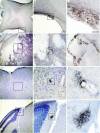Behavioral and Neuropathological Changes After Toxoplasma gondii Ocular Conjunctival Infection in BALB/c Mice
- PMID: 35372100
- PMCID: PMC8965508
- DOI: 10.3389/fcimb.2022.812152
Behavioral and Neuropathological Changes After Toxoplasma gondii Ocular Conjunctival Infection in BALB/c Mice
Abstract
Ocular infection with Toxoplasma gondii causes toxoplasmosis in mice. However, following ocular infection with tachyzoites, the cause of the accompanying progressive changes in hippocampal-dependent tasks, and their relationship with the morphology and number of microglia, is less well understood. Here, in 6-month-old, female BALB/c mice, 5 μl of a suspension containing 48.5 × 106 tachyzoites/ml was introduced into the conjunctival sac; control received an equal volume of saline. Before and after instillation, all mice were subject to an olfactory discrimination (OD) test, using predator (cat) feces, and to an open-field (OF) task. After the behavioral tests, the animals were culled at either 22 or 44 days post-instillation (dpi), and the brains and retinas were dissected and processed for immunohistochemistry. The total number of Iba-1-immunolabeled microglia in the molecular layer of the dentate gyrus was estimated, and three-dimensional reconstructions of the cells were evaluated. Immobility was increased in the infected group at 12, 22, and 43 dpi, but the greatest immobility was observed at 22 dpi and was associated with reduced line crossing in the OF and distance traveled. In the OD test, infected animals spent more time in the compartment with feline fecal material at 14 and at 43 dpi. No OD changes were observed in the control group. The number of microglia was increased at 22 dpi but returned to control levels by 44 dpi. These changes were associated with the differentiation of T. gondii tachyzoites into bradyzoite-enclosed cysts within the brain and retina. Thus, infection of mice with T. gondii alters exploratory behavior, gives rise to a loss in predator's odor avoidance from 2 weeks after infection, increased microglia number, and altered their morphology in the molecular layer of the dentate gyrus.
Keywords: Toxoplasma gondii; behavioral tests; hippocampus; microglia response; neuroinfection; ocular conjunctival instillation.
Copyright © 2022 Soares, Leão, Freitas, Alves, Tavares, Costa, Menezes, Oliveira, Guerreiro, Assis, Araújo, Franco, Anaissi, Carmo, Morais, Demachki, Diniz, Nunes, Anthony, Diniz and Diniz.
Conflict of interest statement
The authors declare that the research was conducted in the absence of any commercial or financial relationships that could be construed as a potential conflict of interest.
Figures






Similar articles
-
Contrasting Disease Progression, Microglia Reactivity, Tolerance, and Resistance to Toxoplasma gondii Infection in Two Mouse Strains.Biomedicines. 2024 Jun 26;12(7):1420. doi: 10.3390/biomedicines12071420. Biomedicines. 2024. PMID: 39061995 Free PMC article.
-
Distribution of cysts and tachyzoites in calves and pregnant cows inoculated with Toxoplasma gondii oocysts.Vet Parasitol. 1983 Oct;13(3):199-211. doi: 10.1016/0304-4017(83)90057-2. Vet Parasitol. 1983. PMID: 6686377
-
Unexpected oocyst shedding by cats fed Toxoplasma gondii tachyzoites: in vivo stage conversion and strain variation.Vet Parasitol. 2005 Nov 5;133(4):289-98. doi: 10.1016/j.vetpar.2005.06.007. Vet Parasitol. 2005. PMID: 16024176
-
[Toxoplasma gondii: a potential role in the genesis of psychiatric disorders].Encephale. 2013 Feb;39(1):38-43. doi: 10.1016/j.encep.2012.06.014. Epub 2012 Aug 21. Encephale. 2013. PMID: 23095600 Review. French.
-
[Problems and limitations of conventional and innovative methods for the diagnosis of Toxoplasmosis in humans and animals].Parassitologia. 2004 Jun;46(1-2):177-81. Parassitologia. 2004. PMID: 15305712 Review. Italian.
Cited by
-
Chronic infection by atypical Toxoplasma gondii strain induces disturbance in microglia population and altered behaviour in mice.Brain Behav Immun Health. 2023 Jun 10;30:100652. doi: 10.1016/j.bbih.2023.100652. eCollection 2023 Jul. Brain Behav Immun Health. 2023. PMID: 37396335 Free PMC article.
-
Contrasting Disease Progression, Microglia Reactivity, Tolerance, and Resistance to Toxoplasma gondii Infection in Two Mouse Strains.Biomedicines. 2024 Jun 26;12(7):1420. doi: 10.3390/biomedicines12071420. Biomedicines. 2024. PMID: 39061995 Free PMC article.
References
Publication types
MeSH terms
LinkOut - more resources
Full Text Sources
Research Materials
Miscellaneous

